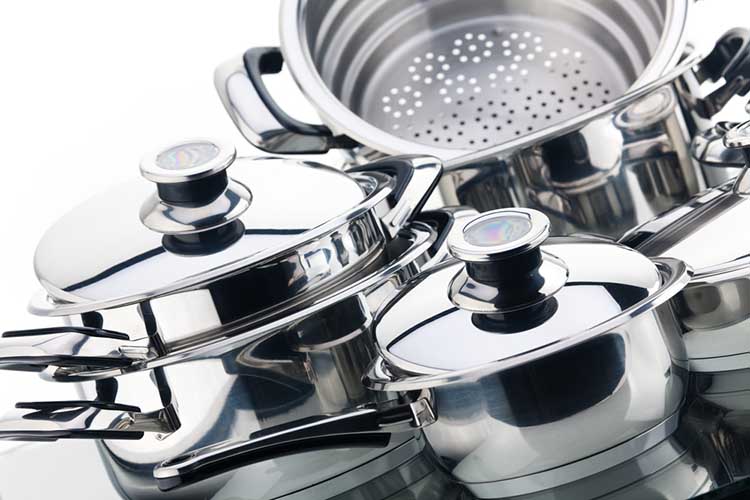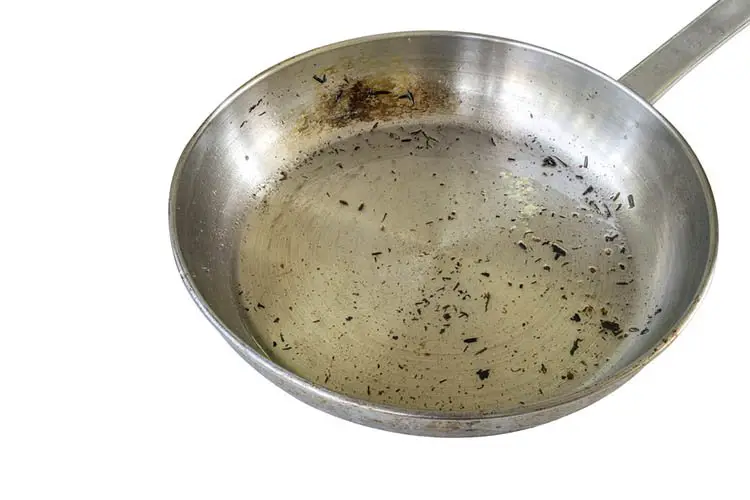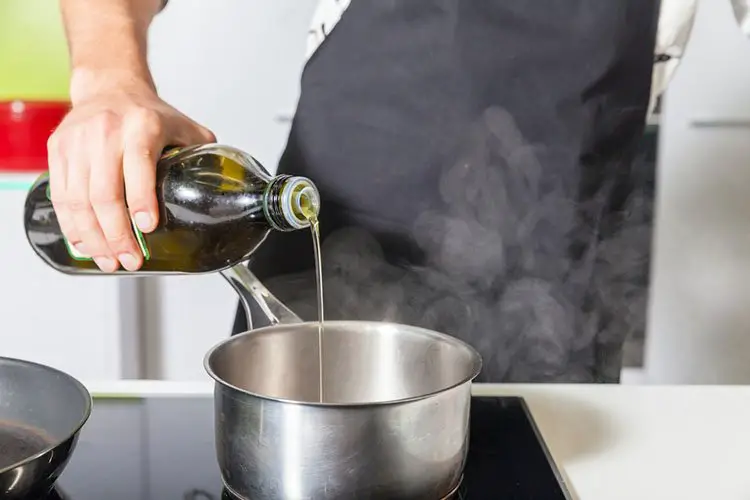A new set of stainless steel cookware is a beautiful thing- all shiny and new. But you’ll want to care and clean for your new cookware properly before preparing your tastiest recipes.
How To Prepare Stainless Pans for First-Time Use
Follow the first two steps to clean your stainless pans before use. The remaining steps will prepare you for cooking and preserving the life of your cookware. You can follow these steps for both new and used stainless sets.
Wash – Either run them through the “pots and pans” dishwasher cycle or wash them by hand. For already used pans, apply about a quarter cup of vinegar to your dishwater to cut away any stuck-on grease. Then, wipe them until smooth with a soft towel or plastic scrubber. Don’t use steel wool on your cookware because it’s too abrasive and will scratch your cookware.
Dry – Take them out of the dishwasher as soon as possible and dry them by hand with a clean, water-absorbent cloth. This will prevent the formation of water spots. Rinse hand-washed pans and immediately wipe them until dry.
Oil – Apply a thin, even coat of oil to the entire pan interior to prevent food from sticking on your untreated, stainless surfaces. A little oil also helps when using treated steel cookware.
Preheat –Heat the empty pan long enough to hear a slight grease sizzle after oiling it.
Place food – Don’t wait too long to add your food to the pan. Otherwise, your grease will burn and damage your pan.
Keep flames low – Lower gas heat settings will prevent flames from burning the sides of pans. Likewise, keep heat only as high as required when cooking on electric burners.
Allow continuous cooking – This will distribute heat beneath the food. If it’s meat, turn it over as soon as it separates naturally from the pan. Stir vegetables frequently to avoid burns.
Clean after use – Wipe the pans with soap and water as soon as the pans are cool enough to touch. This will prevent stubborn grease stains.
How To Clean Stainless Cookware
Use the same steps for general washing as you did when you prepared your pan for first-time use. If you clean your stainless pans right after cooking, it usually takes only a little dishwater and soft cloth. However, you have times when your cookware requires extra maintenance.
How to Tackle Problem Areas
Removing Years of Grime
For this, rubber gloves will protect your hands from burns, so put on a pair before you start this process. Fill a large stockpot about halfway with water and boil it. Add about a half-cup of baking soda into the hot water and stir it and carefully dip the grimy pan into it.
Simmer the pan on lowered heat for about a half-hour. You will notice the grease flakes gradually peel off your pan’s surface. Once this grimy substance has separated from your pan, remove it from the water. Wipe the remaining debris with a gentle scrubbing sponge.
Some stubborn cases might require longer setting times. You can leave your pan in the simmering water for up to a few hours if you want. It will remain intact while loosening up more of the stuck-on debris from it. Wipe all flaky remains from your cookware and inspect your pans to make sure no debris ends up in your next meal.
To Remove Calcium Stains
Boil about a ¼ cup of vinegar in ¾ cup of water for about 10 minutes. You can also let this solution simmer for a little longer on lower heat. When you’re ready, pour out the water and scrub the pan with a non-abrasive, wet cloth. Dry the pan after cleaning to shine it. Repeat the process if necessary.
Scrubbing Burnt Food
It happens – sometimes you burn your food. If so, you can heat the water in the pan to a boil. Let it simmer for about 10-15 minutes. Then, cool the pan enough that it won’t scorch your hand when you attempt to scrub it.
Pour out the water and discard whatever burnt food came loose while boiling. Afterward, make a baking soda and water paste and scrub with gentle force. Beware that the baking soda could cause minute scratching. However, it doesn’t affect the pan heat distribution.
How to Restore Discolored Pans
You can use some of the same methods used to clean silver flatware. Vinegar works wonders for this, but you can also try lemon juice or apple cider for this. Olive oil with seltzer water or club soda also would work.
Soak the pan with some vinegar water for at least a few minutes. Then, use a mild scrubber with dish soap to gradually eradicate the discoloration.
The same baking soda mixture applied to years of stuck-on grease and food also will work. If you see small scratches, apply a little less pressure.
Long-Term Maintenance
Although you can soak stainless steel, avoid letting water sit in them for days. Furthermore, don’t add salt to the water when cooking until after the boiling point. These additional tips will also preserve your cookware.
Cover Your Pans
Keep your pans covered when not using them. This will prevent dust and grease from accumulating in them between uses.
Prevent Scratches
Steel wool and other harsh scrubbing pads cause more than scratches. If you have coated steel pads, these abrasive scrubbing sponges will peel that rubberlike finish right off the surface. Remnants of that coating could even end up in your favorite entrée.
Don’t Overheat
Although stainless cookware can hold quite a bit of heat, you still don’t want to risk burning them. If you do, that’s when the unremovable stains will occur. Never clean them before they’ve cooled. Otherwise, you can warp them.
Soften your Water
This will prevent further mineral depositing that causes calcium stains. It also reduces water spots, especially if washing your pans in a dishwasher.
Dishwasher Use
You can wash stainless in your dishwasher and even let it sit through the machine’s dry cycle. However, the best way to prevent water spots is when you clean them, dry them by hand immediately afterwards.
If you follow these tips to prepare and care for your stainless steel cookware, it can last you a lifetime and serve up many delicious meals.



